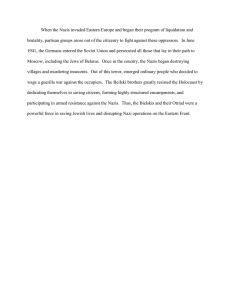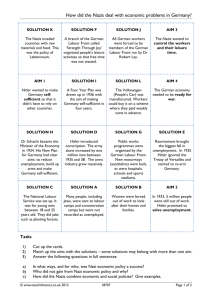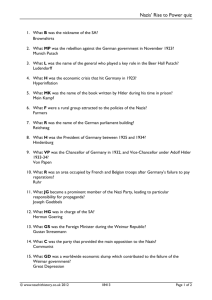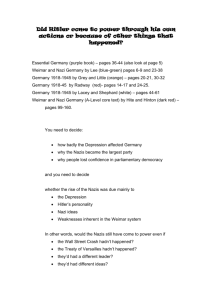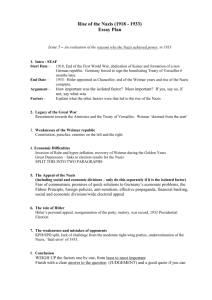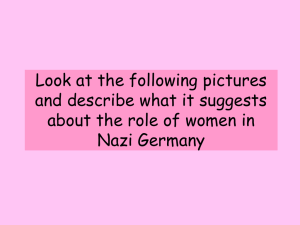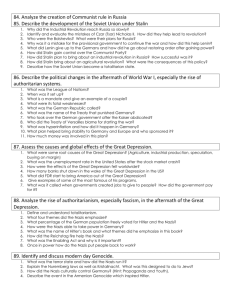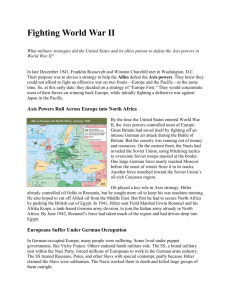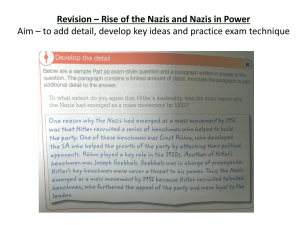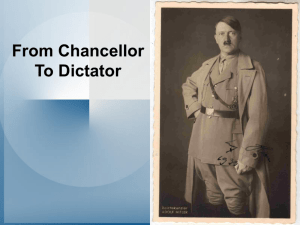#38—Crash Course World History Video Notes World War II 1
advertisement
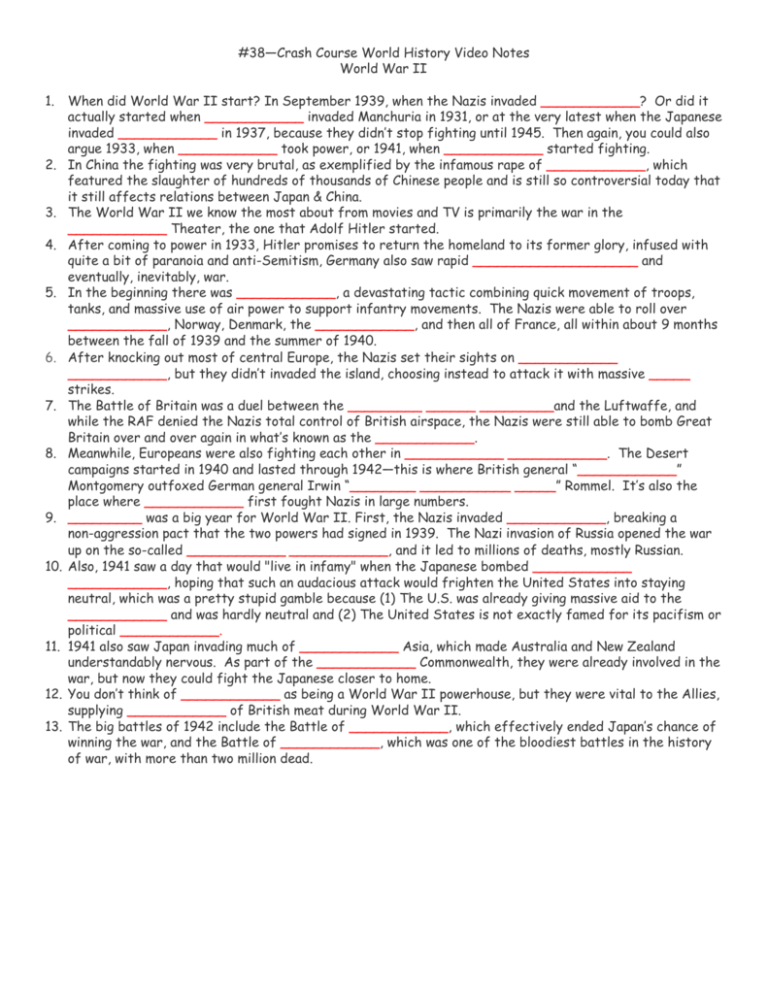
1. 2. 3. 4. 5. 6. 7. 8. 9. 10. 11. 12. 13. #38—Crash Course World History Video Notes World War II When did World War II start? In September 1939, when the Nazis invaded ____________ ? Or did it actually started when ____________ invaded Manchuria in 1931, or at the very latest when the Japanese invaded ____________ in 1937, because they didn‛t stop fighting until 1945. Then again, you could also argue 1933, when ____________ took power, or 1941, when ____________ started fighting. In China the fighting was very brutal, as exemplified by the infamous rape of ____________ , which featured the slaughter of hundreds of thousands of Chinese people and is still so controversial today that it still affects relations between Japan & China. The World War II we know the most about from movies and TV is primarily the war in the ____________ Theater, the one that Adolf Hitler started. After coming to power in 1933, Hitler promises to return the homeland to its former glory, infused with quite a bit of paranoia and anti-Semitism, Germany also saw rapid ____________________ and eventually, inevitably, war. In the beginning there was ____________ , a devastating tactic combining quick movement of troops, tanks, and massive use of air power to support infantry movements. The Nazis were able to roll over ____________ , Norway, Denmark, the ____________ , and then all of France, all within about 9 months between the fall of 1939 and the summer of 1940. After knocking out most of central Europe, the Nazis set their sights on ____________ ____________ , but they didn‛t invaded the island, choosing instead to attack it with massive _____ strikes. The Battle of Britain was a duel between the _________ ______ _________ and the Luftwaffe, and while the RAF denied the Nazis total control of British airspace, the Nazis were still able to bomb Great Britain over and over again in what‛s known as the ____________ . Meanwhile, Europeans were also fighting each other in ____________ ____________ . The Desert campaigns started in 1940 and lasted through 1942—this is where British general “ ____________ ” Montgomery outfoxed German general Irwin “ ________ ___________ _____ ” Rommel. It‛s also the place where ____________ first fought Nazis in large numbers. _________ was a big year for World War II. First, the Nazis invaded ____________ , breaking a non-aggression pact that the two powers had signed in 1939. The Nazi invasion of Russia opened the war up on the so-called ____________ _ ___________ , and it led to millions of deaths, mostly Russian. Also, 1941 saw a day that would "live in infamy" when the Japanese bombed ____________ ____________ , hoping that such an audacious attack would frighten the United States into staying neutral, which was a pretty stupid gamble because (1) The U.S. was already giving massive aid to the ____________ and was hardly neutral and (2) The United States is not exactly famed for its pacifism or political ____________. 1941 also saw Japan invading much of ____________ Asia, which made Australia and New Zealand understandably nervous. As part of the ____________ Commonwealth, they were already involved in the war, but now they could fight the Japanese closer to home. You don‛t think of ____________ as being a World War II powerhouse, but they were vital to the Allies, supplying ____________ of British meat during World War II. The big battles of 1942 include the Battle of ____________ , which effectively ended Japan‛s chance of winning the war, and the Battle of ____________ , which was one of the bloodiest battles in the history of war, with more than two million dead. 14. Stalingrad turned the war in Europe and by 1944; the American strategy of “ ___________ ____________ ” in the Pacific was taking GIs closer and closer to Japan; Rome was liberated in June by Americans and Canadians; and the successful British, Canadian, and American D-Day invasion of ____________ was the beginning of the end for the Nazis. ( Canadians fought with the Royal Air Force to defend Great Britain from the beginning of the war and you were there on D-Day, successfully invading ____________ ____________ .) 15. So, by the end of 1944, the Allies were advancing from the West and the Russian Red Army was advancing from the East and then, the last-ditch German offensive at the Battle of the ____________ in the winter of 1944-1945 failed. 16. Mussolini was executed in April of 1945. Hitler committed ____________ at the end of that month. And, on May 8, 1945 the Allies declared victory in Europe after Germany surrendered ____________ . 17. Three months later, the United States dropped the only two ____________ weapons ever deployed in war, Japan surrendered, and World War II was over. 18. The war had a definite cause: unbridled ____________ expansion by Germany, Japan, and, to a small extent, Italy. 19. There are many possible explanations beyond mere evil; but the most interesting one, to me, involves ____________ . Hitler had a number of reasons for wanting to expand Germany‛s territory, but he often talked about lebensraum or ____________ ____________ for the German people. German agriculture was really inefficiently organized into lots of small farms, and that meant that Germany needed a lot of land in order to be self-sufficient in food production. The plan was to take Poland, ___ ___________ , and Eastern Russia, and then resettle that land with lots of Germans, so that it could feed German people. This was called the Hunger Plan because the plan called for 20 million people to starve to death. Many would be the Poles, Ukrainians, and Russians who‛d previously lived on the land. 20. The rest would be Europe‛s ____________ , who would be worked to death. Six million Jews were killed by the Nazis, many by starvation, but many through a chillingly planned effort of extermination in ____________ camps. These death camps can be distinguished from ________________ camps or labor camps in that their primary purpose was extermination of Jews, Roma people, communists, homosexuals, disabled people, and others that the Nazis deemed unfit. 21. Similarly, Japan, at the beginning of the war, was suffering from an acute fear of food shortage because its agricultural sector was having trouble keeping up with population ____________ . And the Japanese too, sought to expand their agricultural holdings by, for instance, resettling farmers in ____________ . 22. So while it‛s tempting to say that World War II was about the Allies fighting for ____________ ideals against the totalitarian militaristic imperialism of the fascist ____________ powers, it just doesn‛t hold up to scrutiny. 23. For instance, a hugely important Allied power, ____________ Soviet Union, was, like, the least democratic place, ever. Stalin‛s Soviet Union is tied with all of the other completely undemocratic countries for last place on the democracy scale. 24. By far, the biggest imperialists of the war were the ____________ . They couldn‛t have fed or clothed themselves—or resisted the Nazis—without their colonies and commonwealth. 25. So, why is World War II so important? Well first, it proved the old Roman adage homo homini lupus : _____ ___ _____ ___ ______ . This is seen most clearly in the ____________ , but ALL of the statistics are staggering. Millions of civilians died on both sides; some from ____________ while others were targeted because they helped sustain the war, mostly through ____________ and agricultural production. 26. World War II saw modern industrial nations, which represented the best of the ____________ and the Scientific Revolution, descend into once unimaginable cruelty. And what makes World War II such a historical watershed is that in its wake, all of us—in the West or otherwise—were forced to question whether ____________ dominance of this planet could, or should, be considered progress.
